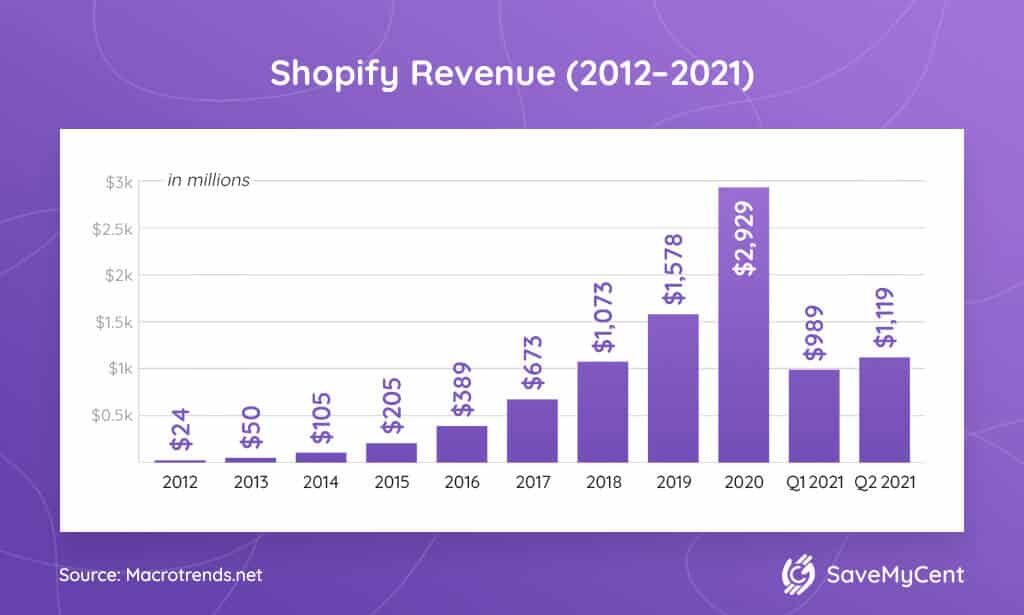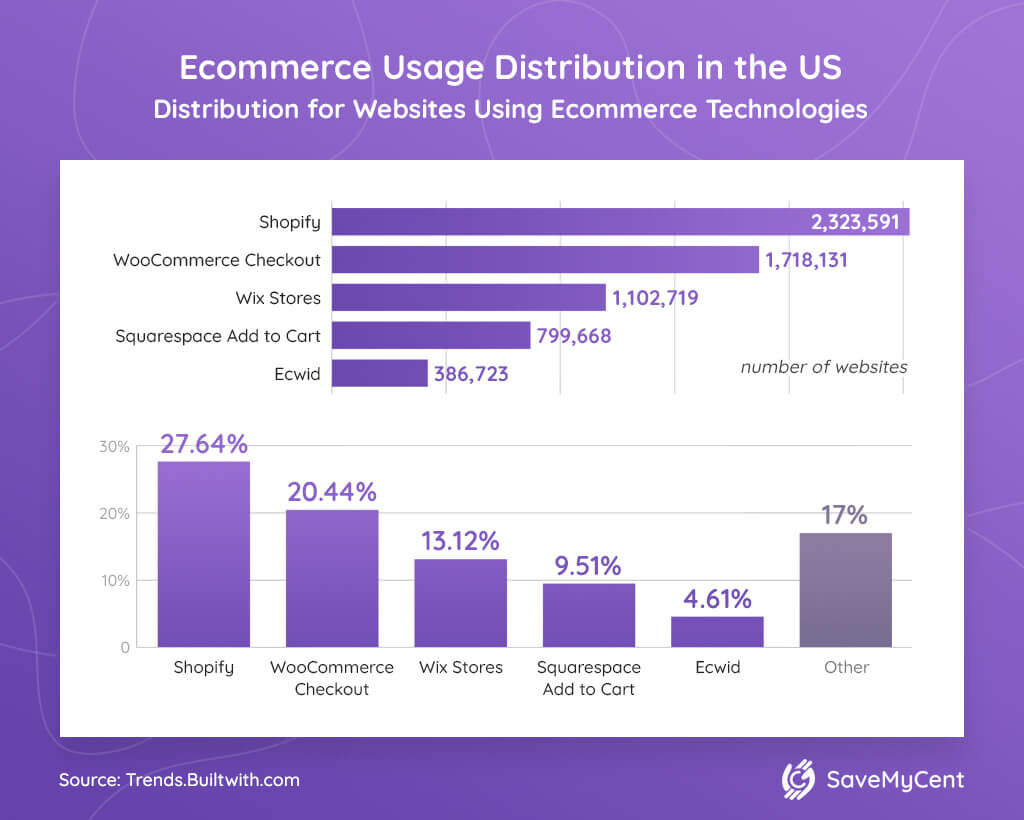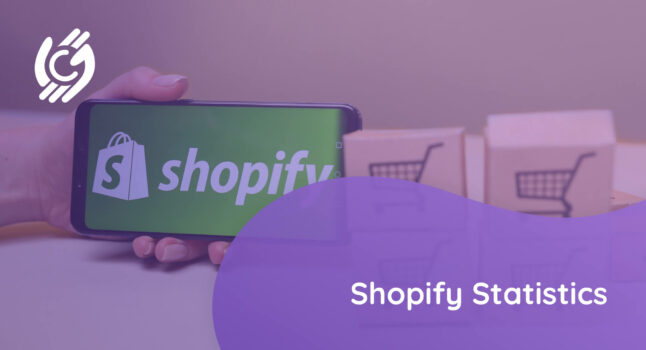In many ways, dropshipping is a business owner’s dream, because it allows you to build an online store and, at the same time, not to worry about keeping goods in stock, hefty upfront costs, fulfilling orders, etc. And the best part is that you get to be your own boss over the entire process.
At the forefront of the dropshipping industry, Shopify remains a contender for the best dropshipping platform. The current Shopify statistics look unbelievable. The business now crosses international borders as platforms like AliExpress have made it possible for Chinese suppliers to enter the market.
Some Mind-Blowing Shopify Stats and Facts (Editor’s Pick)
- Shopify currently has more than 1 million merchants.
- Shopify is the third most popular dropshipping platform at a 11,80% market share.
- In Q3 2020, Shopify‘s revenue growth equaled 96% of increase compared to the same period in 2019.
- Shopify hit the billionth order in the 2nd quarter of 2018, and by September 2020, the platform had $6.12 billion in cash, cash equivalents and marketable securities.
- China is the leading country for Shopify users.
- Shopify’s earnings are forecast to grow 41.4% in 2021.
Shopify Growth Statistics
1. Shopify store statistics show that they currently have more than 1 million merchants.
(Shopify)
Shopify has more than one million stores in about 175 countries. The company announced that its number of merchants surpassed the one million mark worldwide in 2019.
2. Shopify market share statistics show that Shopify is the third most popular dropshipping platform at 11.80% after SquareSpace at 21% and WooCommerce at 27.86%.
(Datanyze)
Shopify is a robust platform where you can control everything from domain name to content management. It is also its own ecommerce CMS so there are no additional charges for web hosting, and you don’t even need another software as a website builder.
3. In 2020, Shopify’s revenue for the trailing twelve months reached $2.929 billion.
(Macrotrends)

This $2.929 billion was an 85.63% increase from 2019, which was at $1.578 billion. If we look at Q2, Shopify’s revenue increased 56,71%, with an amount of $1.119 billion.
Including the upcoming holiday season, Shopify’s total revenue will reach new heights.
4. Shopify hit the billionth order in the 2nd quarter of 2018 and by May 2018, the total sales-to-date for all merchants were at $55 billion.
(Shopify)
Since June 2019, there have already been 218 million buyers on the platform, with over $100 billion in total sales-to-date. By October 2019, Shopify total sales have increased to a figure well over $135 billion.
5. Shopify managed to raise $131 million in IPO.
(Shopify)
Shopify went public on the New York Stock Exchange in May and at the time, they were selling their shares for $26. Little did the investors know that Shopify would grow into the giant it is today, with shares costing $332.67 a piece.
6. 81% of traffic on Shopify traffic stats comes from mobile users.
(Website Builder)
Of this 81%, 71% of orders were made via mobile devices by the end of 2019. This percentage can be seen increasing from 67% to 77% in 2018. Search engines contribute to the majority of Shopify’s traffic as it brings 28.93% of Shopify’s visits.
7. Shopify’s traffic is 93.95% organic.
(SimilarWeb)
Although influencer marketing remains the most significant way of acquiring traffic, Shopify’s traffic is almost entirely organic. The top five organic Shopify keywords include Shopify (14.8%), Shopify Login (6.97%), Business name generator (0.70%), Shopify apps (0.62%), and Shopify Themes (0.64%).
8. Only 6.05% of Shopify traffic is paid.
(SimilarWeb)
Shopify’s paid keywords include Shopify (5.06%), Dropshipping (0.19%), Etsy (0.24%), Shopify Pricing (0.08%), and Web Store (0.06%).
9. Statistics show the average conversion rate is 1.5%.
(Convertize)
The standard Shopify conversion rate is between 1.5% to 1.75% on average. Some bigger stores reach 2%. There are also exceptions, and businesses that are really thriving have conversion rates between 10% to 12%. The regular bounce rate for websites is between 26% to 41%. Shopify’s bounce rate is considered excellent at 53.23%.
10. 350,000 paid Shopify themes used by merchants.
(Ecommerce Platforms)
There are over 100 free and paid-for Shopify themes that merchants can choose for their stores. All themes are specially designed and created for each individual while keeping in mind the components to boost sales.Workiee and Porto (used by over 40,000 eCommerce sites) are two of the most popular themes used by merchants in 2020. There are also some Shopify themes that have been proven to boost traffic such as Konversion, Booster, and eCom Turbo.
11. There were 422.5 million visits on Shopify within the last six months of 2020.
(SimilarWeb)
Shopify visitor statistics show that these visitors are predominantly from the US with 39.50% using desktops for their purchases. The number of visits is followed by Canada’s 6.10%, UK’s 5.46%, Australia’s 3.99%, and India’s 2.92%. Live numbers are updated on SimilarWeb.com. The average visit on Shopify takes around 3 minutes and 52 seconds and interacts with at least 3 stores per visit.
2020 BFCM Shopify Stats
12. 2020 Black Friday Cyber Monday Shopify statistics show over $5.1 billion in sales over 175 countries.
(Shopify)
$102 million per hour was the peak sale recorded at 12 PM ET on Black Friday. Most items purchased were from categories of apparel and accessories, health and beauty, followed by home and garden.
13. 50% more people shopped from independent and direct-to-consumer businesses on Shopify compared to the previous year.
(Shopify)
This percentage translates to over 44 million consumers participating in the sale and buying from shopify’s small businesses, lending a helping hand to independent stores during a global crisis.
14. New York, Los Angeles, and London take the lead for top-selling cities worldwide during the sale.
(Shopify)
Among the top-selling cities worldwide, both New York and London took the lead. Whereas the countries with most sales included the US, UK, and Canada.
Something that’s particularly characteristic of the 2020 holiday season is its earlier start. So during the week prior to Cyber Monday, total sales had increased by 84% compared to 2019.
15. Mobile is still the preferred shopping method even during sales.
(Shopify)
The favourite consumers’ shopping method is via mobile order with 67% of purchases made on phones and tablets and only 33% on desktop computers.
Shopify Plus Statistics
Shopify Plus is for enterprises using Shopify as it comes with several benefits such as more customization flexibility, adding more than one staff accounts, and lower transaction fees. It is designed to benefit store owners with higher volumes of orders.
16. Over 5,300 businesses on Shopify Plus.
(Shopify Plus)
These businesses include premium brands such as Lorenzi Milano, Bremont, The Wool Company, and Victoria Beckham.
17. Shopify Plus merchants generate between $1 million to $500 million in sales.
(Shopify Plus)
Every minute, there are 10,149 peak orders via Shopify Plus.
18. The number of Shopify Plus merchants grows every year by 126%.
(Shopify Plus)
On top of this, Shopify Plus merchants have sales revenues between $1 million and $500 million and this includes Fortune 500 companies and high-volume brands.
Shopify App Statistics
The ecommerce market statistics for Shopify show that the evolution of the ecommerce industry is greatly influenced by the innovations in technology, especially application development. To stay on top of their game, Shopify regularly releases downloadable tools and plugins that merchants can use to enhance their Shopify stores. These tools and customizable templates and themes help Shopify to stay competitive as it allows users more flexibility to suit their brands.
19. Over $100 million has been made in Shopify’s app profits as 87% of merchants use them for their businesses.
(Indie Hackers)
Shopify has 1,323 app developers coming up with innovative tools and plugins. By the end of 2018, Shopify had over 2,426 apps on its platform and this number is increasing as time passes. Each Shopify merchant uses an average of 6 apps.
20. There are over 2,400 Shopify apps available on the app store.
(Indie Hackers)
There are over 2,400 Shopify apps, of which 1,815 (74.8%) are paid apps, while free apps total 611 (25.2%). Of this, 2,038 (84%) of the apps remain active.

Countries Where Shopify is Available
Although originally from Canada, Shopify is available in many different countries, and is now mostly used in Asia, North America, and Europe.
21. Global B2C ecommerce is estimated to rise from $4.2 trillion in 2020 to $4.9 trillion.
(Statista, Grand View Research)
In 2019, the retail ecommerce sales worldwide hit $3.35 trillion and this figure is expected to double by the year 2022. The numbers for B2B and B2C ecommerce together are even more fascinating: the combined market was estimated at around $10.36 trillion in 2020.
22. The highest ranking for ecommerce regional markets is Asia ($831.7 billion).
(Statista)
This is immediately followed by North America ($552.6 billion), Europe 9$346.50 billion), Australia ($18.6 billion), Africa and the Middle East ($18.6 billion), and South America ($17.7 billion).
23. Shopify has over 1,000,000 businesses spanning across 175 countries.
(Shopify)
Shopify is just 20 countries away from total world domination as these countries do not allow access to the platform due to strict governmental internet regulations.
24. China is the leading country for Shopify users, followed by the US, France, Australia, Russia, Canada, Germany, UK, Japan, and South Korea.
(Statista)
China currently has the largest five-year growth of 70.7% with $636.1 billion revenue in 2018. The US follows with 45.7% five-year growth and $504.6 billion in total ecommerce revenue in 2018. The competitive Chinese market has successfully knocked the US into second place. According to the Statista Research Department, the US share of global retail ecommerce sales declined from 2015 to 2020. Another 16.9% decrease is projected for 2020.
25. Asia currently ranks the highest in ecommerce regional markets.
(McKinsey & Company)
Asia Pacific (APAC) is expected to overtake the world retail ecommerce sales by the year 2023. There are many reasons for this big change, but it’s mainly due to technological advancements and rapid urbanization. APAC will consist of 85% of middle-class residents around this time who are the best targets for ecommerce businesses.
Shopify Sales Statistics Prediction For 2021
A reputable investment blog computed some data from previous growth to estimate the Shopify success rate for 2021 and the results are very promising.
26. 2021 looks promising for Shopify as earnings are forecast to grow 41.4% per year.
(Investors, Simply Wall St)
At the time of writing, a Shopify share costs $1,125.06. It is projected that shares will rise, as revenue is expected to increase by 31% in 2021. However, every projection in 2021 should be taken with a pinch of salt, as the economic crisis and the pandemic introduce more volatility into the market.
Most Successful Shopify Stores
Successful Shopify stores achieve their successes via different strategies. While some stores have the help from influencer marketing through famous founders, others drive traffic in other ways to boost conversions and maximize profits every year. Other than getting sales, some of these large companies use these platforms to connect with their customers, building a bond that will eventually reflect in annual revenue.
Budweiser
Budweiser is a popular American-style lager that is one of the most successful brands on the platform, and they’re not selling beer on the platform. They use Shop Beer Gear, their Shopify ecommerce store, to create bonds and engage with their customers, build their target audience, share the latest information, and sell merchandise. Yup, due to restrictions on selling alcohol, the brand has improvised and is now doing well-selling merchandise like apparel, lifestyle products, barware, etc.
Tesla
Tesla is a brand that sells itself, as it’s well-known for its eccentric founder, Elon Musk. The Tesla Shopify page is sleek and clean, reflecting their brand and products. Their store works as seamlessly as it looks and visitors always leave with great satisfaction.
Red Bull
Going on the online market has boosted Red Bull revenues significantly. Like Budweiser, Red Bull isn’t profiting from selling their beverages online due to restrictions. They make their online revenue by selling merchandise such as footwear, headgear, apparel, accessories, etc.
Companies That Use Shopify
Over the thousands of stores on Shopify, there are several industries that seem to be especially popular with their online purchasing items. According to Shopify sales and revenue statistics, retail takes the lead with 12,534 stores, followed by apparel and fashion with 6,772, and wholesale with 3,999 stores. There are several large businesses using Shopify and it makes up 24% of Shopify’s revenue. Here are some of the biggest Shopify stores:
Nestle
Nestle uses the platform to reach a whole new market of international customers. To celebrate their 150th birthday, Nestle started a marketing campaign targeting millennials for their Nescafe Sweet and Creamy Instant coffee. The campaign centered around making adulthood more bearable for millennials who are just entering the adult age. Arlee Rosenberg was part of the campaign and she claims that Shopify was their chosen partner for their quick launch. The results were impressive, to say the least. There was a 70% conversion rate by giving away 21,000 over Nescafe samples over the year. Just a few hours after launching, Nescafe was already 90% closer to achieving its goals.
The Economist
The Economist is another big brand that uses Shopify. The Economist is an English newspaper that looks like a magazine. It contains every topic under the sun including politics, finance, science, etc. Ron Diorio is the person responsible for coming up with the brand’s innovative ideas like using the ecommerce platform to test out products before they launch. According to Diorio, Shopify allows them to test-launch and scrap projects that aren’t working and adapt accordingly. He praises Shopify’s responsiveness and ability to help his team whenever they encounter any difficulties.
Other influential brands using Shopify include Pepsi, Budweiser, Red Bull, Tesla Motors, Penguin Books, and WaterAid.
Random Shopify Facts
- Three Canadians founded Shopify in 2004 after an unsatisfactory experience with selling snowboarding equipment online.
- Brand loyalty for Shopify merchants is very positive as more than half of them receive twice as many purchases as other stores. 14% of Shopify’s buyers, which account for 62 million people, have purchased twice from the same store.
- A Shopify Capital review shows that Shopify Capital had a growth of 85% from 2018 ($76.4 million) to 2019 ($141.0 million) in merchant cash advances and loans. Since its launch in 2016, Shopify Capital has raised about $768.9 million in cumulative advanced cash.
- Shopify Shipping is growing, with around 44% merchants in the US and Canada using the service.
- Shopify Sustainability Fund raises $5 million every year for carbon sequestration, neutralizing its carbon footprint and encouraging merchants to cooperate.
- Shopify pays ethical hackers to resolve vulnerability issues. Shopify has paid over $850,000 rewards to around 300 ethical hackers for resolving 759 vulnerability cases that could have caused them big data breach problems. Shopify’s average response time is 6 days faster than other ecommerce giants and retail industry brands. It takes them an average of 3 hours on HackerOne to resolve an issue.
To Wrap Up
Overall, Shopify trends show a bright future for the dropshipping platform. What’s not to love? An all-rounded dropshipping platform that takes care of the merchant’s every need is what you need to succeed in the dropshipping business. Several notable giant corporations can attest to this as big companies like Tesla, CrossFit, Foo Fighters, and Encyclopedia Britannica (to name a few) stand by the platform. From what we can see, it is Shopify’s flexibility that allows its clients to see such massive success and in return Shopify statistics are soaring up.
They’ve successfully made a platform where people with no coding or programming skills can succeed in business. The ever-growing ecommerce industry, coupled with Shopify’s ability to listen and change according to their merchants’ needs will most likely spell a successful and bright future for the platform.
FAQ
How Many Shopify Users Are There?
So, how many people use Shopify? In April 2017, Shopify usage statistics showed 1 million active users on their platform. By October 2019, Shopify was supporting 1.4 million full-time jobs.
What Companies Use Shopify?
According to the Shopify statistics for 2020, Gymshark takes the lead for the most successful Shopify store. The brand has come a long way from founder Ben Francis’s garage. Gymshark is a fitness brand based in the UK, and you’ve probably seen your favourite sport influencers talk about them in their vlogs or videos. In 2018, Gymshark grew 200% in revenues, hitting $128 million, a 256% growth compared to 2017.
The next most successful Shopify store is Kylie Jenner’s Kylie Cosmetics. Officially the youngest billionaire, Kylie has since sold $630 million worth of makeup. Her success comes mainly from influencer marketing where she uses her social media to promote her products. It also helps that she has equally or even more famous siblings or in-laws helping her to promote her products with the same influencer marketing.
Another Shopify brand to note is Fashion Nova. Most searched in 2018, Fashion Nova outranks big brands like Gucci, Versace, and even Louis Vuitton. Fashion Nova’s first store was located in Panorama City back in 2006. Their ecommerce website launched in 2013 and at the time, they only had 60,000 followers on Instagram. Currently, their follower count is over 17 million and counting. Fashion Nova’s success comes from a mix of influencer marketing and selling good quality, reasonably priced products.
How many Shopify stores are there in 2020?
As of March 2020, there are currently 820,000 active stores running on Shopify.
How much money can be made on Shopify?
The amount of money you can make on Shopify varies, as there are a lot of factors to consider. The general rule is that the more you work, the more you can earn. Specific business skills can make or break your business, affecting the success rate and ultimately your profits. Different niches also have different success rates. How much money you can make also depends on good marketing strategies such as SEO marketing, online advertising, strategy, branding, and public relations.
How many Shopify stores are successful?
According to a list on Oberlo, there are currently 65 inspiring and successful Shopify stores on the platform including SkinnyMe Tea, Happiness Abscissa, Flex, among a long list of others.
Sources:


![26 Genius Shopify Statistics That Will Impress You [2024 Edition]](https://savemycent.com/wp-content/uploads/thumbs_dir/18-Mobile-App-Usage-Statistics-1-qbrsvl5x6feuf0p2wa2h20pigkxm5tvey9ppimfdj0.jpg)
![26 Genius Shopify Statistics That Will Impress You [2024 Edition]](https://savemycent.com/wp-content/uploads/thumbs_dir/39-Social-Commerce-Statistics-1-qbrtm61mfrsqq235orookb8r6tx9tpe5xtu02b0lks.jpg)



![How to Get Free Clothes From Shein? [2024 Guide]](https://savemycent.com/wp-content/uploads/2023/09/How-to-Get-Free-Clothes-From-Shein-336x220.png)
